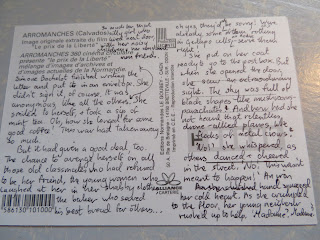A couple of weeks ago, I read a blog somewhere - maybe even on here - about a new challenge a writer had set herself: she had decided to write a story on a postcard every day for a month. (At least, I think that was it; something along those lines, anyway.) Alongside this, for some time now I've been signed up to a delightful site called Postcards from Pembrokeshire. If you haven't seen this, do take a look. Artist Guy Manning (who I think is the partner of Eloise Williams, of this parish) has undertaken to do a postcard sized painting every day for a year of Pembrokeshire, where he lives. If you subscribe, you receive an email every day with his latest offering, and if you want, you can buy one. They're very lovely, especially, to my mind, the ones of the sea.
Now. I'm going to tell you a secret, which you must keep very, very quiet. All right? Not a word to a soul - not a word. It's this. Some writers - probably most writers - absolutely FIZZ with ideas. The only problem such writers have is deciding which idea to focus on. No sooner have they started one book than they're itching to start the next, and then the one after that.
But sadly, I'm not like that. When I have an idea, it sort of implants itself. It won't leave me alone. If I try to tell the story one way and it doesn't work, I'll prowl around like a bear with a sore head and eventually I'll try it another way. Sometimes I long to root it out and chuck it away, but no, there it is. I'm stuck with it. There's no other idea waiting to sprout - there's just the one.
 |
| My card box, with the cards I've 'done' so far. |
And suddenly there it was - a brilliant way to challenge myself and get some ideas kick-started. Every day, I would aim to write something on the back of a postcard, inspired by the picture on the front. It might be a story, it might be a beginning, it might be a scene from the middle of a longer story - it might not even be a story at all!
And I'm absolutely loving it! Each postcard takes me somewhere utterly different. I've already learnt a lot more about shaping a story, and about knowing where to start it. Each day, I get to meet completely new characters - it's extraordinarily energising! I'm having ideas - lots of them! And it doesn't take very long, so there's still plenty of time to return to the work in progress. It's also rather nice to sit down at my desk and NOT open up my computer: I'm not distracted by Facebook and other goodies, and I'm not encumbered by the weight of my own expectations concerning ongoing work.
Here's one of them - I've typed it out below so that you can actually read it. I get about 250 words onto the back of each card. I allow myself to make one or two notes before I start, and if necessary to do a tiny bit of research, but not to let myself get bogged down.
It's such fun. You can write in a way you normally wouldn't; you can be a tad melodramatic, for instance. It's playing, it's allowed! What do you think?
 |
| This postcard came from a museum in Arromanches. It's a still from a film called Le Prix de la Liberte, and it shows a sky full of parachutes - the D-Day landings. |



6 comments:
A post well worth revisiting - thanks, Sue!
A good post to see here again. Good luck with the sudden edits!
First time reading this, Sue, and very enjoyable. What a brilliant idea!
Interesting, isn't it, how people who informed on their neighbours, or slept with a few Germans.., were the subjects of VE day vilifications. Many will have seen the old newsreel clips of tarring and feathering.
Anyone with money,,, influence..., just seemed to melt away, unemcumbered, to reappear after the war... like it had all never happened. The only real major collaborationist figure in France, who actually paid a price, that I recall, was Pierre Laval.
Coco Chanel..., sitting out the war in the beautiful hotel, with her German officer.
Maurice Papon..., Vichy collaborator, enthusiastically embraced Nazi policies, transportation, deportation of Jews to concentration camps. After the war, he continued on with a high ranking career of repression, and torturing. He became the head of police in Paris, and was responsible for the massacre in Paris of Muslims in a peaceful demonstration. Hundreds were either thrown in the Seine, or died of their injuries. October 1961.
Papon was protected. No one talked about it. The press censored. In the late '60's De Gaulle appointed Papon as head of Sud Aviation. They made the first Concorde. Only in 1997 was he made accountable, and convicted of crimes against humanity. Died in 2007, not in prison, at the age of 96
Post a Comment